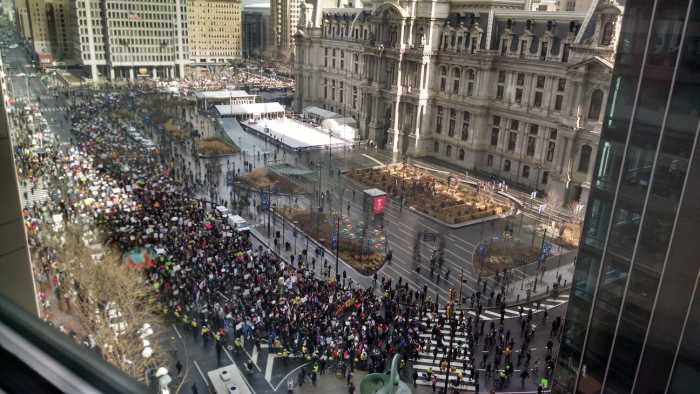A Venezuelan father waiting in Mexico to plead his U.S. asylum case who has yet to meet his newborn daughter. An Iraqi refugee stuck in Jordan despite his past helping U.S. soldiers. A mother sent back to Honduras after being separated at the U.S.-Mexico border from her two young children. A Malian package courier deported after three decades in the United States. And an Iranian couple kept apart for years under a U.S. travel ban.
They have all experienced first-hand the effects of Republican President Donald Trump’s signature domestic policy goal in his nearly four years in office – the overhaul of the U.S. immigration system. A multitude of new bureaucratic hurdles to entering or staying in the United States have upended the lives of hundreds of thousands of people around the world.
Trump says the changes were necessary to fix an immigration system he has characterized as broken and riddled with loopholes. As he campaigns for a second term, immigration is once again a key plank of his platform.
While immigrants have faced hurdles settling in the United States for generations and illegal immigration has bedeviled both Republican and Democratic administrations, critics contend no recent administration has moved faster and more aggressively to carry out a restrictive immigration agenda.
Now, many immigrants are in a new phase of uncertainty, waiting to see who will win the November presidential election – Trump, or his Democratic opponent Joe Biden. Trump plans to expand and solidify his changes to the immigration system in a second term, while Biden has vowed to undo many of them if he wins.
But the sheer number of new policies mean that many people waiting in limbo are affected by not only one new Trump measure but several layered on top of each other. Many families have been waiting years to resolve their immigration cases, and regardless of what happens in the election those waits are likely to drag out further.
“A lot of people have it in their mind that a Biden administration would come in and reverse everything,” said Sarah Pierce, a policy analyst with the Migration Policy Institute, a Washington-based think tank, but “a lot of the policy changes were layered with the intent of making them difficult to walk back.”
“It would be impossible for a new administration to undo everything because there is so much to do,” Pierce said. “People’s lives have already been altered.”
Here are the stories of some of them.
DREAMS FADE AFTER TRAVEL BAN
Masoud Abdi hasn’t seen his wife Shima Montakhabi since Feb. 1, 2017.
Days earlier, in one of his first acts as president, Donald Trump barred most people from Iran, Iraq, Libya, Somalia, Sudan, Syria, and Yemen from coming to the United States, citing the need to protect the country from “terrorist activities by foreign nationals.”
The couple, who met and married in Iran, were living in Tehran and waiting for Montakhabi’s visa to be approved when the ban was announced. Abdi, who is a U.S. permanent resident, had a permit that allowed him to spend up to two years outside the United States without losing that status.
But when he saw the news about the ban he panicked. While permanent residents were eventually declared unaffected, in the fog of those first few days Abdi was taking no chances.
He returned to the United States and has not left since, fearing further restrictions that could put his green card and pending U.S. naturalization application at risk. Montakhabi, a pharmaceutical researcher, remained in Iran, her visa application pending.
A physician in Iran, Abdi first came to the United States in 2010 after winning a green card through the diversity lottery. That program – which Trump has criticized – aims to accept immigrants from countries that are not normally awarded many visas.
When he and Montakhabi applied for her visa in late 2015, they had hoped to be starting a family in Champaign, Illinois within a couple of years at most. Now, they are both in their forties and that dream is beginning to fade.
The couple try to speak every few hours, Abdi said. But sometimes the internet doesn’t work in Iran and they can’t communicate for several days. When this happens, Abdi said, his depression worsens. “Talking to her is all that gives me motivation for living,” he said.
The U.S. Supreme Court allowed a revised version of the travel ban to take effect in December 2017. It has since been expanded to additional countries.
Through August 2020, more than 41,000 people seeking immigrant and non-immigrant visas have been affected by the ban, according to the State Department. The issuance of immigrant visas to Iranians dropped almost 80% from fiscal year 2016 to 2019, State Department data shows.
Biden has said he would lift the travel ban if he is elected. But Abdi and Montakhabi are affected by other policy changes, too.
As he waits in Illinois, Abdi says he cannot afford to reduce his hours as a clinical researcher. A more stringent wealth requirement for people sponsoring their relatives to join them in the United States and a separate proclamation requiring new immigrants to have sufficient funds to cover healthcare costs worry Abdi, who fears Montakhabi may be barred if his earnings were to drop. Those measures are being challenged in court, but in the meantime, Abdi has less time to pursue his U.S. medical license.
Another new ban also affects the couple. The administration stopped issuing almost all new family-based green cards in April 2020 until the end of the year, saying the move would protect American jobs amid the pandemic. Spouses of U.S. citizens are exempt, but Abdi is still waiting for naturalization. Under Trump, naturalization processing times have nearly doubled, according to data from U.S. Citizenship and Immigration Services (USCIS).
“This is not the America of my childhood, the land of opportunity,” he said. “It’s not a land of opportunity for me. I’m stuck here and my wife is stuck in Iran.”
The State Department said it could not comment on individual visa cases.
SEPARATED, NEVER REUNITED
Maynor tries to keep everyone’s spirits up. He is good at it – a skill he has honed as a street vendor hustling to sell oranges in California to make enough money to feed himself and his two young sisters. But it’s hard when his mother, Maria, who lives in Honduras, calls to talk to her children and just cries.
“I tell her she has to try to motivate them,” Maynor, 32, said of his sisters. “But they start crying when they hear her cry.”
The last time the sisters saw their mother was almost three years ago, when Michelle was 8 years old and Nicole just 3 and still breastfeeding. The family is not being identified with their last name because the girls are minors and their attorney is concerned about hurting their ongoing U.S. immigration case.
Maria and her daughters were caught crossing the U.S.-Mexico border near San Luis, Arizona, in December 2017, at a time when the Trump administration was rolling out what would become one of its most controversial policies – a crackdown on illegal crossings that led to thousands of migrant family separations.
After a few days in detention, a border agent came to take the girls away, Maria said. The 3-year-old grabbed on tight to her mother and they all sobbed, she recalled. Maria was bussed to an adult detention center and didn’t know where her daughters were for nearly two weeks.
“That whole time period is just a blank,” Maria said. “I didn’t want to bathe, or do anything. I wanted to die.”
She was eventually told by U.S. officials that her daughters had been sent to a shelter in California near where their brother Maynor lived.
Maria had been deported previously after trying to cross into the United States years earlier. During her three months in detention, Maria says she was told by an attorney her only option was deportation: either with her children or alone.
U.S. Immigration and Customs Enforcement (ICE) confirmed the dates of her deportation in 2009 and the separation from her children and subsequent deportation in 2018. The Department of Health and Human Services’ Office of Refugee Resettlement, which houses migrant children, said it could not comment on the cases of her daughters due to privacy concerns.
Maria said she fled Honduras after gang members threatened Michelle, and the idea of her daughters returning to one of the most violent countries in Central America made her panic.
“They gave me no real choice,” she said in a telephone interview from Honduras. “I went back totally destroyed.”
More than 2,700 families were separated between when Trump officially announced a ‘zero tolerance’ policy to prosecute all illegal border crossers in May 2018 and its abrupt reversal months later in the face of an international outcry.
But the Department of Health and Human Services inspector general said thousands of children were separated both before and after that period. Some parents were separated from their children because they were being criminally charged for illegally crossing the border, others over questions about their identities or previous records, according to court filings.
The girls went to stay with Maynor, who was living with his girlfriend and his newborn at the time. But his girlfriend told him she didn’t want the extra burden of caring for his sisters, so kicked Maynor and the girls out, he said.
“There was a time when Nicole would close herself in her room, she wouldn’t eat or come out. The babysitter would call me and I would have to leave work to console her. That would happen almost every day,” said Maynor.
Now the girls may try to apply for asylum or a form of relief known as Special Immigrant Juvenile status, or SIJ. But a series of changes put in place by the Trump administration has made that process more difficult. Trump’s attorneys general have issued rulings to narrow who is eligible for asylum based on claims of gang violence, for example, and increased their scrutiny of SIJ cases.
Maria works cleaning houses and still sees the gang members who she said threatened her daughter. She breaks down every time she talks about being apart from her children.
“Even if they told me I could see them once a year, on a particular date, I would go and leave again,” Maria said. “I would do anything, just to see them again.”
A FATHER TRAPPED, YET TO MEET HIS BABY
In May, Landys Aguirre’s 2-month-old daughter was admitted to an intensive care unit in Chicago with a high fever. He could see, in photos and grainy videos his wife Karla Anez sent him, that the baby’s face, arms and legs were swollen.
Aguirre, alone 1,500 miles (2,400 km) away in a hotel room in Mexico under a signature Trump administration program meant to deter migration, began to sob, wishing he could be there to comfort Anez and their daughter, whom he had yet to meet.
The couple fled Venezuela in 2019 to seek political asylum as supporters of an opposition party. Aguirre said he had been kidnapped and tortured by pro-government groups. The pair presented themselves at a U.S. port of entry with copies of a forensic exam and photographic evidence of Aguirre’s torture. Reuters reviewed the documents but could not independently confirm Aguirre’s claims of persecution.
Aguirre said he never got a chance to present the documents to an asylum officer.
Instead, he was ordered to wait in Mexico for a U.S. court hearing under the Trump administration program known as Migrant Protection Protocols (MPP) put in place in January 2019, which has sent tens of thousands of asylum seekers to wait in Mexican border towns. The administration said the program discourages “false asylum claims.”
U.S. border officials make case-by-case determinations of who is placed in the program. Anez, five months pregnant at the time, was allowed in to fight her asylum case. She headed to Chicago to join her mother, who had arrived two years earlier.
She sent Aguirre pictures as she grew more heavily pregnant and when she gave birth in March. In May, when his daughter fell ill and he feared she might die, he considered swimming across the Rio Grande – the river that marks the border between the United States and Mexico – but decided against it.
He felt his asylum case was strong and he did not want to jeopardize it. After more than a week in hospital, the baby recovered.
“It’s maddening, cruel, harsh and painful to be here in Mexico alone, with no help, in danger and missing my wife and my daughter, who I haven’t met,” Aguirre said.
“I presented myself voluntarily at a port of entry to ask for asylum, not so they could send me to Mexico like a criminal when I am a professional with two degrees fleeing political persecution.”
U.S. Customs and Border Protection said it could not comment on individual cases due to privacy concerns.
Biden has pledged to end the program if he wins in November. But it is not clear what the fate of those now stuck in the program would be. Many are living in tent camps, shelters and rented rooms in dangerous neighborhoods in Mexico, risking kidnappings and extortion.
Anez and Aguirre’s chances for U.S. protection also hinge on the fate of another Trump rule, one that barred asylum for almost anyone who transited through a third country and did not seek refuge elsewhere first. It was struck down in federal court and is now on hold, but that ruling could still be overturned by the Supreme Court.
And Anez, applying for asylum, could face new barriers to the issuance of a work permit and other limits proposed in new rules.
Aguirre remains in a hotel in Reynosa – one of the most violent cities in Mexico – as he waits for his asylum hearing date. Originally set for April 6, it has been delayed four times due to the pandemic.
It is now scheduled for November.
DEPORTED AFTER THREE DECADES
Ibrahima Keita was walking to his car ahead of his morning school run in the suburbs of Cincinnati on May 22, 2018, when two immigration agents pulled up and arrested him for being in the country illegally.
Keita asked if he could take his sons to school first, since his wife, Neissa Kone, did not have a driver’s license. The agents told him that was not possible. They did, however, knock on the door to tell his wife and sons what was happening.
His sons, Abdul, then 5 years old, and Solomon, then 7, burst into tears. Kone fell to her knees, pleading with the ICE agents not to take her husband, she said.
Keita, 61, originally from Mali, had been in the United States since 1990.
Fleeing a dictatorship, he crossed illegally into the United States from Canada and applied for asylum. Seven years later, at a court date to plead his case, his lawyer never arrived, he said. Not knowing he was allowed to attend the hearing alone, he waited outside the courthouse for hours. The judge ordered him deported from the United States for not showing up, according to court documents seen by Reuters.
Mali would not issue Keita travel documents, so he stayed. In 2008, ICE put Keita, who has no criminal record, on an ‘order of supervision,’ which allowed him to work in the United States as long as he regularly checked in. ICE confirmed the dates of Keita’s removal order and his subsequent supervision order.
During his later years in office, former Democratic President Barack Obama focused on deporting immigrants with criminal records, but Trump shifted that focus in an executive order on Jan. 25, 2017 so that no immigration violators would be spared automatically from enforcement.
ICE said in a statement that the implementation memo that accompanied the executive order made clear that the agency would no longer exempt “classes or categories” of immigrants from enforcement and anyone “in violation of the immigration laws may be subject to immigration arrest, detention and, if found removable by final order, removal from the United States.”
The administration also said it would ramp up pressure on countries that had been uncooperative in accepting deportees.
In fiscal year 2016, the last of the Obama administration, around 14% of immigrants arrested by ICE had no criminal convictions. That percentage rose to more than 35% of all ICE arrests in 2019, according to government data.
After a year in detention, ICE chartered a plane in May 2019 and sent Keita to Bamako, Mali’s capital. ICE said Keita failed to cooperate with a removal via commercial aircraft in 2018. Keita said he was doing everything he could to try to fight his deportation.
For the family, following him was not an option because Solomon, the oldest boy, has sickle cell anemia, a rare blood disorder that requires specialized care, not easily available in Mali.
After their father’s deportation, Solomon internalized his grief while his younger brother Abdul “let it all out,” Kone, 48, said. He cried in a way she had never heard him cry before “as if someone had died.” He started cutting himself.
Keita calls them three to four times a day, Kone said, and tells them to stay hopeful. He lives in a small apartment near his parents, aged 88 and 92, in Bamako. Kone reads the news and worries: Mali’s president was recently ousted in a military coup, potentially further destabilizing the West African nation.
Keita was the family’s breadwinner when he worked as a package courier in Ohio. Kone, who is also from Mali and overstayed a tourist visa 20 years ago, does not have permission to work and after their savings ran out could no longer afford to pay rent. She and the boys moved to accommodation provided by a church, then to a hotel under a local effort to house homeless people in hotel rooms to prevent the spread of the coronavirus.
She said she hopes that a Biden win will make “everything normal” again. But seeking the repatriation of someone who has already been deported would require an order from a judge to reopen the case, a complicated legal process, immigration attorneys said.
“We never asked for help. We had a good life, a nice house in the suburbs, he worked so hard,” Kone said. “Now everything is upside down.”
LEFT STRANDED AFTER HELPING U.S. SOLDIERS
In Iraq, Amer Hamdani worked for U.S. military contractors, providing security support for American installations. Now, he often struggles to feed his family as he waits in Jordan to gain entry to the United States as a refugee.
The 44-year-old’s former job made him a high priority for resettlement under a special program for Iraqis at risk because of their association with the U.S. government since the 2003 U.S. invasion of Iraq.
He said he fled with his wife and three children in 2014 after friends told him that his name was on an assassination list of people who had worked with U.S. companies, compiled by followers of populist cleric Moqtada al-Sadr.
While he awaits a decision on his application for refugee status in the United States, he does not have permission to work in Jordan. He has relied on money that his brother has sent from Texas.
“The situation is miserable,” he said. He lives on the outskirts of the capital Amman. “I didn’t think the U.S. would abandon us like this,” he said.
Due to the U.S. involvement in Iraq and Afghanistan, demand for the special program Hamdani applied for dramatically expanded, leading to backlogs under previous administrations, refugee experts said.
Hamdani had already submitted his application when Trump won the presidency. But after Trump took office in January 2017 the administration began dramatically slashing the size of the refugee program.
In the 2020 fiscal year, the United States said just 18,000 refugees would be allowed in, the lowest level since the modern refugee resettlement program began in 1980. While 4,000 of those spots were carved out for Iraqis who supported U.S. interests, only 118 people in that category had been admitted as of mid-September.
In addition, 11 countries, including Iraq, faced new, extra levels of vetting. Admissions for those countries slowed to a trickle.
Now U.S. officials are weighing whether to postpone or further cut refugee admissions in the coming year, throwing Hamdani’s application, which had been cleared for travel in early 2020, further into doubt.
Resettlement organizations say that while refugee applications can take many years, the delays faced by refugees from the countries selected for extra vetting have grown significantly.
In fiscal year 2016, before Trump was elected, the United States admitted 9,880 refugees from Iraq. That dropped to 144 just two years later in 2018 and 465 in the 2019 fiscal year, according to government data.
The State Department said it could not comment on specific cases but that the “steep decline” and increased processing times for Iraqis who helped U.S. forces is “due to ongoing security conditions in Iraq and travel limitations due to COVID-19.”
As the number of refugees overall has dropped, the proportion of Muslim refugees compared to Christians has also declined, according to an analysis of government data shared with Reuters. In fiscal year 2017, 43% of the 53,716 admitted refugees were Muslim while 44% were Christian. In fiscal year 2020 through mid-August, 71% of the 8,310 refugees allowed were Christian and just 21% were Muslim, the data showed.
Biden’s campaign has pledged to admit 125,000 refugees a year if he is elected. But the dramatic downsizing of the program could lead to longer-term backlogs even if the cap is quickly lifted.
With fewer people coming in each year under Trump, offices run by nonprofits and funded by the government that help arriving refugees have closed around the country.
Reopening them may not always be possible, resettlement organizations say, leaving new refugees with fewer services.
The Trump administration also signed an executive order mandating that local governments would have to consent to resettlement in their communities.
The measure was challenged and blocked by a court but Texas’ Republican Governor Greg Abbott was the first statewide elected official to say he did not want to welcome refugees before the judge’s ruling.
Hamdani is waiting to join his brother near Dallas, Texas.




























